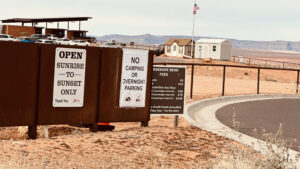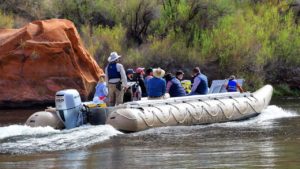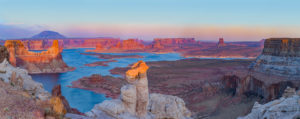
As travelers plan their spring and summer vacations to Northern Arizona, the Grand Canyon, and Lake Powell, invariably the topic of Horseshoe Bend comes up. For some, it comes with a heaping helping of trepidation about the length and difficulty of the walk to the overlook.
Since we know you’re busy, we’ll save some of you some time right now: 9 out of 10 of you who are in reasonably good health, not afraid of heights, and who walk regularly or participate in even a moderate exercise regimen will be able to make this “so-called” hike. Wear good walking shoes, sunscreen and a hat, and carry water. You’ll be good to go!
As for those who aren’t so sure where they stand, you’ll be glad to know that you’re not alone. Many prospective visitors in your shoes have gone to the one place people go to either assuage their fears – or confirm them: the travel forums of TripAdvisor!
A recent poster, Kav3 asks:
“How difficult is the Horseshoe Bend hike for a 74-year-old woman with some arthritis? Trying to decide if we should skip this…”
MarianReader, a frequent poster and Destination Expert for Tempe, AZ, replies:
“You might want to skip it. The hike is uphill, a portion of it through a sandy trail, no railings at the top, no shade at any time.”
 That was then, this is now! Improvements made pre-COVID, such as an expanded, paved parking lot and installation of public restrooms, also included grading the Horseshoe Bend Overlook trail to a flatter, more gradual incline. The total round-trip walk is now 1.4 miles, but today, visitors in wheelchairs and strollers report being able to make the trek with assistance and relative ease. Check out this Facebook video by Finley-Holiday Films to see this for yourself.
That was then, this is now! Improvements made pre-COVID, such as an expanded, paved parking lot and installation of public restrooms, also included grading the Horseshoe Bend Overlook trail to a flatter, more gradual incline. The total round-trip walk is now 1.4 miles, but today, visitors in wheelchairs and strollers report being able to make the trek with assistance and relative ease. Check out this Facebook video by Finley-Holiday Films to see this for yourself.
Before completion of the parking lot, StlCardFan would have seemed to concur, coming back with a very detailed and accurate description of the former Horseshoe Bend Overlook trail:
“The first part, from the parking lot to the top of the rise is fairly steep, and the sand is soft and deep. You will be huffing a bit when you get to the top. (Think walking on a soft beach uphill). Then it is down to the bend itself. This is less steep, and there is some smooth rock areas on the way down. The sand is not as “deep”, but it is about three times further a hike than that first rise from the (parking) lot. This is easy to go down, but again, on the way back, even though it is less deep and not as steep, it is further, still a sand trail, and will wear you out in the sun.”
Today’s Horseshoe Bend Overlook Trail, managed by the City of Page, is partially paved, regularly graded, and offers a small shade pavilion and safety platform for those leery of heights.
RedRox, Destination Expert for Sedona, offers a word of caution that still stands today, not only for those who are a bit out of shape, but for those traveling with children:
“The Horseshoe Bend overlook is a short but challenging hike in the direct sunlight (no shade), and no barriers at the edge, so caution is advised especially with youngsters or those with height issues.”
You read correctly: no barriers at the edge. Even with the installation of the safety platform, the majority of Horseshoe Bend’s real estate remains unfenced, so you can enjoy the view without man-made obstructions!
So what’s a person to do if they’re unable to manage the walk to Horseshoe Bend? Be content to look at everyone else’s selfies or just fantasize that they saw it? Not necessarily.
Here’s what we would suggest:
How slow can you go? As slow as you want! First off, the trail to Horseshoe Bend is relatively short, a little more than half a mile (0.7 mi) each way. The biggest challenge you’ll likely face is heat, especially if the Page area is in the midst of a summer dry spell. There is no water provided at the trailhead, so you must bring your own. Sun protection is a must. What To Bring To Horseshoe Bend Nevertheless, it’s not a race. You are welcome and encouraged to take the walk at your own pace, even if said pace is inch by inch and bit by bit. Concrete benches have also been placed every few hundred yards. Obviously, you’re not the first person who may need or want to stop and rest on the way there! Visiting Horseshoe Bend Overlook right when the parking lot opens at sunrise will also make the walk it easier to manage, and you’ll have fewer people to compete with for the perfect photo op.
If you decide to take a chance, remember that you can always turn back if you feel as though you’ve bitten off more than you can chew, but many people who were at bit dubious at first felt the view they were rewarded with was well worth the effort expended, like Carolina R., a visitor to our Facebook page:
“(The walk) was longer than expected. Nonetheless, it was so worth it. Absolutely breathtaking!”
Still not convinced? There are other options.
Get down in it. See Horseshoe Bend up close and personal, on the Horseshoe Bend Raft Trip or Kayak Horseshoe Bend tour!

On these scenic, relaxing river excursions suitable for young children and people of all physical fitness levels, you’ll be transported by bus or backhaul raft to the base of the Glen Canyon Dam . From there, you’ll glide on custom-built rafts or paddle down the very stretch of the Colorado River that people on the rim are gazing down at. Give them a wave and they’ll usually wave back! You’ll travel 15 miles downstream on the last remaining intact stretch of Glen Canyon before disembarking at Lees Ferry.
The only part of this trip that might be somewhat strenuous for people with mobility issues is the hike to the petroglyph panel that occurs about midway through the trip. Though relatively short, here again, the trail is sandy, and shade is minimal to non-existent. Hats, sunscreen, water, and a towel that can be dipped in the water and placed around your neck or shoulders as an evaporative cooler are must-bring items. River tours are only offered between mid-March and late-October; departure times vary by season.
Get up above it. How would you like to see Horseshoe Bend, the Glen Canyon Dam and much more? How many steps will you need to take? Two: one up, and one down. Fixed wing airplanes take flight over Horseshoe Bend and Lake Powell daily from the Page Municipal Airport. In less than an hour’s time, you’ll gain a true appreciation for the true scale and scope of Horseshoe Bend as it relates to the surrounding landscape, and soar past the towering monoliths of Lake Powell, including Lone Rock, Romana Mesa, Alstrom Point, Castle Rock and the Historic Crossing of the Fathers. The man-made wonders of Glen Canyon Dam and the Steel Arch Bridge round out this aerial sightseeing bonanza that many people regard as being better than the Grand Canyon!

This bird’s-eye perspective is one shared by only a select few. If you would like to be one of them, visit Horseshoe Bend and Lake Powell Air Tour. Tours operate weather permitting and may require a certain number of passengers to guarantee operation.
Approach it from a different angle. On Horseshoe Bend Tours’ Secret Antelope Canyon & Horseshoe Bend Tour, you’ll tour a beautiful slot canyon with no stairs, and view Horseshoe Bend from an exclusive private overlook on Navajo Indian Tribal Land. Whereas the Page City Park overlook involves a .7 mile one-way hike to the rim of Glen Canyon, guests on this 2-for-1 guided tour need only walk 100 yards to the spectacular, Insta-Famous view that has elevated Horseshoe Bend to one of the Top 5 Attractions in Grand Canyon East.
‘Til next time, happy traveling!